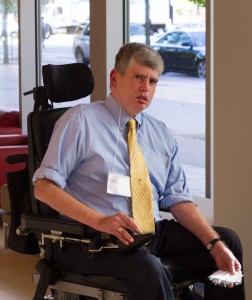Living with and fighting against a deadly disease
By Jessica Bartlett, Boston Business Journal

Dan Perez, President and CEO of the FSH Society, has testified nearly 40 times before Congressional committees to seek funding for research into the deadly genetic muscle disease.
Living with FSHD himself, Perez knows firsthand how dire the mission is to find a cure. And in the days since the FSHD Connect Biennial Meeting in Boston from August 16-17, 2014, Perez is more enlivened than ever.
In an exclusive email interview, Perez discusses what it is like to have FSHD, the mantra behind the Society, and how the group’s search for funding has reached a critical juncture.
Boston Business Journal: How has FSHD impacted your life?
DP: FSHD has been in my family and the disease has had a profound impact — for the better — despite the devastating ravages of the disease. People who have FSHD must cope with continuing, unrelenting, never-ending losses. The most unlucky, those who are affected from birth, are deprived of virtually all the ordinary joys and pleasures of childhood and adolescence.
But no matter at which stage of life the disease makes itself known, there is never after that any reprieve from continuing loss of physical ability, or ever for a moment relief from the physical and mental pain that FSHD brings in its train. Every morning, FSHD sufferers wake up to face the reality that neither a cause for their disease nor any treatment for it has yet been found.
BBJ: When did you found the FSH Society and why?
DP: From its inception, the FSH Society has been patient-driven. The idea of creating a mechanism to provide FSH Dystrophy (FSHD)-affected persons and their families with FSHD-related information and to promote FSHD-specific scientific and clinical research was conceived in 1988 by two men affected by the disease, Stephen J. Jacobsen, PhD, and me … Dr. Jacobsen was already in the process of establishing a national FSHD cell bank, and contacts with persons involved in his study led to the development of a grassroots organization dedicated to FSHD issues.
A Board of Directors was created and donations were solicited. By late summer of 1993, thanks to generous donations of time and money from FSHD-affected persons and their families and friends, the FSH Society was a fully functioning organization.In accordance with its primary purpose of serving the FSHD community, both in the United States and abroad, the FSH Society, through outreach at home and international networking, has brought together more than 6,000 FSHD-affected families committed to working cooperatively. From the moment of their introduction into the FSH Society, these families, and, in many instances, their friends, are bonded with their fellow members both by their common knowledge of what it is to live with FSHD and by the ardent desire they all feel to be part of a concerted effort to discover how to treat the disease and, ultimately, to cure it.
When founding the Society in 1991, I felt that the lack of progress on FSHD could no longer be attributed to acts of ignorance, passive omission, benign neglect and lack of technical tools from medical and clinical research agencies and by society as a whole. Hence, I envisioned an independent and principled society of members, who charged themselves with the more specific goal focusing on an issue affecting a very specific population. Hence, the name of the corporation is the FSH Society.
In addition, at that time, there was an almost hermetic isolation of FSHD individuals that had a detrimental impact on the FSHD community as a whole. FSHD had become an almost invisible and unknown disorder although having been identified more than 125 years ago as a separate, distinct and unique devastating disorder. Today, it is known as the most prevalent muscular dystrophy. Simply, my endeavor was and still remains to help increase funds available to researchers and to help provide funds to generate pilot data and discovery of FSH muscular dystrophy. Read more.
This excerpt is reprinted with the permission of the Boston Business Journal. The article was originally published on August 19, 2014. It is available online here.


I was diagnosed last year with FSHD. I would like to know more and find out about treatments for this disease
Welcome to our community!